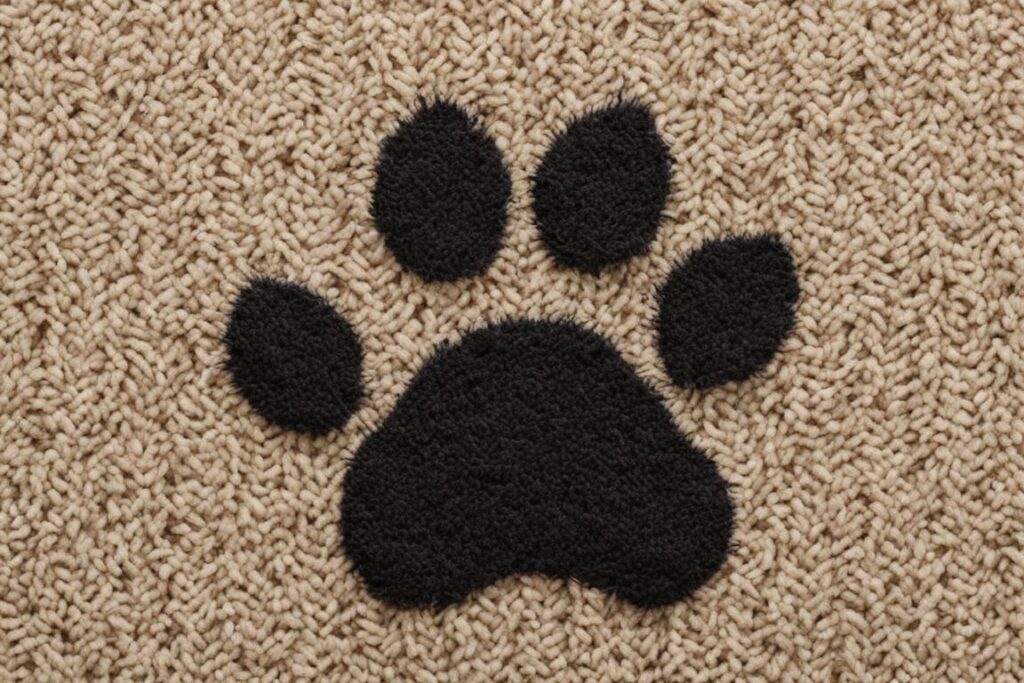Dogs scratching the carpet can be a frustrating behavior for owners to deal with. There are several reasons why dogs exhibit this behavior, including natural instincts, health issues, and anxiety. Dogs may scratch the carpet to satisfy their natural digging instincts, mark their territory, simulate hunting behavior, or relieve anxiety and boredom. Additionally, allergies, parasites, dry skin, and lack of exercise or stimulation can contribute to carpet scratching. It’s important to understand the reasons behind this behavior in order to effectively prevent and correct it, ensuring a happy and healthy home environment for both the dog and the owner.
Key Takeaways:
- Understanding the reasons behind carpet scratching behavior can help prevent and correct it.
- Natural instincts, such as digging, marking territory, and hunting, can contribute to carpet scratching.
- Health issues like allergies, parasites, and dry skin can also lead to excessive scratching.
- Anxiety and stress can drive dogs to scratch the carpet as a form of relief.
- Providing proper exercise, stimulation, and environmental enrichment can help prevent excessive carpet scratching.
Natural Instincts
Dogs’ scratching behavior can be attributed to their natural instincts. Dogs are descendants of wolves and have inherited behaviors related to digging, marking territory, and hunting. Digging is a natural behavior that wolves use to create dens and regulate body temperature. Dogs may scratch the carpet as a way to satisfy their natural digging instincts. Additionally, dogs have scent glands in their paws and may scratch the carpet to mark their territory. Some dogs may also scratch the carpet as a way to simulate hunting behavior, which is another natural instinct.
| Natural Instincts | Associated Behaviors |
|---|---|
| Digging | Creating dens, regulating body temperature |
| Marking territory | Scratching with scent glands in paws |
| Hunting | Simulating hunting behavior |
Understanding these natural instincts can help owners better comprehend their dogs’ behavior and address it effectively. By providing alternative outlets for digging, such as designated digging areas, and engaging dogs in activities that mimic hunting behavior, such as interactive toys or puzzle games, owners can redirect the urge to scratch the carpet and fulfill their dogs’ natural instincts in a more desirable manner.
Health Issues
Carpet scratching in dogs can sometimes indicate underlying health issues that need to be addressed. It’s important for owners to be aware of these potential health problems in order to provide the appropriate treatment and relief for their furry friends.
Allergies are one common health issue that can contribute to excessive scratching, including on the carpet. Dogs can be allergic to various substances, such as pollen, dust mites, and certain foods. These allergens can cause itching and discomfort, leading dogs to scratch themselves, including on the carpet.
Parasites, such as fleas and ticks, can also cause dogs to scratch and bite their skin, including the carpeted areas of the home. These external parasites infest the dog’s fur and can trigger intense itching, driving the dog to scratch excessively.
Dry skin is another health issue that can result in itching and scratching behavior in dogs. Just like humans, dogs can experience dry skin due to factors such as low humidity, bathing with harsh shampoos, or underlying health conditions. Dry skin can lead to discomfort and compel dogs to scratch themselves, including on the carpet.
Common Health Issues Contributing to Carpet Scratching:
| Health Issue | Description |
|---|---|
| Allergies | Allergies to pollen, dust mites, or certain foods can cause itching and excessive scratching, including on the carpet. |
| Parasites | Infestations of fleas and ticks can lead to intense itching, causing dogs to scratch and bite their skin, including the carpeted areas. |
| Dry Skin | Dogs may experience dry skin due to various factors, which can result in discomfort and scratching, including on the carpet. |
When observing excessive carpet scratching in dogs, it’s crucial to consult with a veterinarian to determine if any underlying health issues are present. Through a proper diagnosis and appropriate treatment, the health issues contributing to the scratching behavior can be addressed, helping to alleviate the discomfort and reduce the urge to scratch the carpet.
Anxiety and Stress
Dogs may scratch the carpet as a way to relieve anxiety and stress. Separation anxiety is a common cause of carpet scratching, as dogs may engage in this behavior to cope with the stress of being left alone. Dogs who are boredom or have excess energy may also scratch the carpet as a way to release pent-up energy. Additionally, dogs who are fearful or anxious may scratch the carpet as a way to self-soothe and alleviate their anxiety. Providing a comfortable environment, addressing separation anxiety, and ensuring dogs receive enough exercise and mental stimulation can help alleviate anxiety-related carpet scratching.

“Anxiety is love’s greatest killer. It makes others feel as you might when a drowning man holds on to you. You want to save him, but you know he will strangle you with his panic.” – Anaïs Nin
Other Reasons
In addition to natural instincts, health issues, and anxiety, there are other reasons why dogs scratch the carpet. Lack of exercise and lack of stimulation can contribute to this behavior, leading dogs to seek alternative outlets for their energy and boredom.
Dogs who don’t receive enough exercise may resort to scratching the carpet as a way to release pent-up energy. Regular physical activity is essential for dogs to maintain their overall well-being and prevent them from engaging in destructive behaviors.
“A tired dog is a well-behaved dog. Providing ample exercise opportunities can help alleviate the need for your furry friend to scratch the carpet,” says Dr. Sarah Johnson, a veterinarian at Healthy Paws Animal Clinic.
Boredom is another factor that can lead to carpet scratching in dogs. When dogs don’t have sufficient mental and sensory stimulation, they may resort to scratching the carpet as a way to entertain themselves.
“Dogs are intelligent creatures and require mental stimulation to keep them engaged and happy. Providing interactive toys, puzzles, and regular playtime can help combat boredom and prevent excessive carpet scratching,” suggests pet behaviorist Emily Thompson.
Lack of stimulation can also contribute to carpet scratching. Dogs may scratch the carpet as a way to relieve boredom and find sensory stimulation. Providing environmental enrichment, such as interactive toys, puzzle feeders, and sensory experiences, can help fulfill a dog’s need for stimulation and prevent excessive carpet scratching.

By addressing the lack of exercise and stimulation, owners can significantly reduce or eliminate their dogs’ tendency to scratch the carpet and promote healthier and more fulfilling behaviors.
Signs of Excessive Carpet Scratching
It’s important for owners to proactively identify signs of excessive carpet scratching in their dogs. Recognizing these signs early can help prevent further damage and address any underlying issues that may be causing the behavior. Here are some common signs to look out for:
- Visible scratch marks: Take a close look at your carpet or flooring. If you notice visible scratch marks, it suggests that your dog is scratching the carpet extensively.
- Damage to carpet or flooring: Excessive scratching can lead to wear and tear on the carpet or flooring. Look for frayed or torn areas that may be a result of your dog’s scratching behavior.
- Dirt and debris accumulation: Constant scratching or digging can cause dirt and debris to accumulate around the areas where your dog scratches. This can be a sign of excessive carpet scratching.
- Constant scratching or digging behavior: If you observe your dog engaging in constant scratching or digging behavior on the carpet, it’s a clear indication that they are scratching excessively.
By paying attention to these signs, you can take appropriate measures to address the issue and prevent further damage to your carpet or flooring. Understanding the signs of excessive carpet scratching is the first step toward finding solutions to this behavior and ensuring a happier, healthier home for both you and your furry friend.

Consequences of Excessive Carpet Scratching
Excessive carpet scratching can lead to various consequences for both dogs and the home environment. Let’s explore the potential outcomes of this behavior:
- Health Issues: Excessive scratching can result in skin irritation, leading to redness, sores, and discomfort for dogs. It may also trigger allergic reactions, causing itching, hives, and other allergic symptoms. Additionally, constant scratching can create openings in the skin, making dogs more prone to parasite infestations.
- Carpet and Flooring Damage: Excessive scratching can cause significant damage to carpets and flooring. Dogs’ claws can shred carpet fibers, leading to fraying, holes, and an unsightly appearance. The repeated scraping motion can also damage hardwood or laminate flooring, resulting in scratches and dents.
- Odors: Dogs’ scratching behavior can release dirt, debris, and pet dander trapped in carpets, leading to unpleasant odors in the home. Furthermore, excessive scratching may cause dogs to scratch themselves vigorously, resulting in the spread of bacteria and further contributing to foul smells.
To illustrate the consequences of excessive carpet scratching, consider the following table:
| Consequence | Details |
|---|---|
| Health Issues | Skin irritation, allergic reactions, and increased risk of parasite infestations. |
| Carpet and Flooring Damage | Frayed carpet fibers, holes, scratches, and dents on hardwood or laminate flooring. |
| Odors | Release of trapped dirt, debris, and pet dander, contributing to unpleasant smells in the home. |
It is crucial for dog owners to address excessive carpet scratching promptly to prevent these consequences from affecting both their pet’s health and the condition of their home.
Preventing and Correcting Excessive Carpet Scratching
Preventing and correcting excessive carpet scratching in dogs requires a combination of strategies to address their physical and psychological needs. One key aspect is providing proper exercise and mental stimulation to help fulfill their energy and behavioral requirements. Regular walks, playtime, and interactive toys can keep dogs physically active and mentally engaged, reducing their inclination to scratch at the carpet.
Another crucial factor is addressing anxiety and stress in dogs. Seeking professional help, such as a certified dog behaviorist, can provide valuable guidance in creating a comfortable environment and implementing strategies to alleviate anxiety. Calming techniques, such as soothing music or pheromone diffusers, can also help reduce the desire to scratch.
Regular vet check-ups play a significant role in preventing excessive carpet scratching. These check-ups allow for the early detection and treatment of any underlying health issues that may contribute to the behavior. Ensuring dogs are up-to-date on vaccinations, flea and tick prevention, and maintaining good overall health can minimize factors that trigger excessive scratching.
Positive reinforcement training is a powerful tool in redirecting a dog’s behavior away from carpet scratching. Rewarding alternative behaviors, such as using a scratching post or engaging with a toy, can help dogs associate positive experiences with these activities. Consistency and patience are key when implementing training techniques.
Lastly, providing toys as distractions and solutions can be effective in preventing and correcting excessive carpet scratching. Interactive puzzle toys, chew toys, and treat-dispensing toys can engage dogs mentally and redirect their attention from the carpet. Offering a variety of toys and rotating them frequently can help keep dogs interested and satisfied.
FAQ
Why do dogs scratch at the carpet?
Dogs may scratch the carpet for various reasons, including fulfilling their natural instincts, addressing health issues, relieving anxiety and stress, or due to other underlying reasons.
What are the natural instincts that lead dogs to scratch the carpet?
Dogs have inherited behaviors from their wolf ancestors, such as digging to create dens and regulate body temperature, marking territory with scent glands in their paws, and simulating hunting behavior.
Are there any health issues that can cause dogs to scratch the carpet?
Yes, allergies, parasites like fleas and ticks, and dry skin can contribute to excessive scratching, including on the carpet.
Can anxiety and stress lead dogs to scratch the carpet?
Absolutely. Dogs may engage in carpet scratching as a way to cope with separation anxiety, boredom, fear, or general anxiety. Providing a comfortable environment and addressing these issues can help alleviate the behavior.
Besides natural instincts and health issues, are there any other reasons dogs scratch the carpet?
Yes, dogs may scratch the carpet due to a lack of exercise, stimulation, or boredom. Engaging dogs in physical and mental activities can help prevent excessive carpet scratching.
How can I determine if my dog is engaging in excessive carpet scratching?
Signs of excessive carpet scratching include damaged carpet or flooring, visible scratch marks, dirt and debris accumulation around the scratching area, and constant scratching or digging behavior.
What are the consequences of excessive carpet scratching?
Excessive carpet scratching can lead to health issues such as skin irritation, allergic reactions, and parasite infestations. It can also cause damage to the carpet and flooring, resulting in costly repairs or replacements. Additionally, it can create odors in the home.
How can I prevent and correct excessive carpet scratching in my dog?
Preventing and correcting excessive carpet scratching requires providing proper exercise and mental stimulation, addressing anxiety and stress, scheduling regular vet check-ups, using positive reinforcement and training techniques, and providing toys as distractions and solutions.



